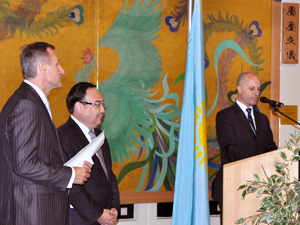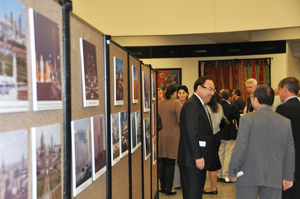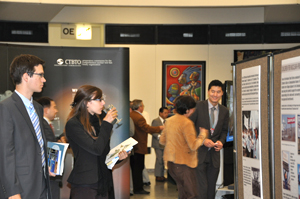 Vienna International Centre - At a large gathering of Ambassadors, diplomats, UN staff, representatives of the civil society and media, a ceremony was held at the Vienna International Centre (VIC) on 30 August to observe the first
International Day against Nuclear Tests. The ceremony, which included introductory remarks by the Permanent Representative of the Republic of Kazakhstan to International Organizations in Vienna, Ambassador Yerzhan Kazykhanov and the Executive Secretary of the Preparatory Commission for the Comprehensive Nuclear-Test-Ban Treaty Organization (CTBTO) Tibor Tóth was moderated by the Director of the United Nations Information Service in Vienna, Maher Nasser. The statements were followed by a reception hosted by the Permanent Mission of Kazakhstan and a viewing of the joint CTBTO/Kazakh exhibition.
Vienna International Centre - At a large gathering of Ambassadors, diplomats, UN staff, representatives of the civil society and media, a ceremony was held at the Vienna International Centre (VIC) on 30 August to observe the first
International Day against Nuclear Tests. The ceremony, which included introductory remarks by the Permanent Representative of the Republic of Kazakhstan to International Organizations in Vienna, Ambassador Yerzhan Kazykhanov and the Executive Secretary of the Preparatory Commission for the Comprehensive Nuclear-Test-Ban Treaty Organization (CTBTO) Tibor Tóth was moderated by the Director of the United Nations Information Service in Vienna, Maher Nasser. The statements were followed by a reception hosted by the Permanent Mission of Kazakhstan and a viewing of the joint CTBTO/Kazakh exhibition.
Ambassador Yerzhan Kazykhanov emphasized Kazakhstan's dedication to the creation of a world free of nuclear weapons: "From the founding of the nation, Kazakhstan has advocated for the peaceful use of nuclear energy and the abolishment of nuclear weapons". Ambassador Kazykhanov emphasized that these efforts were also reflected in the proposal by the Government of Kazakhstan to the United Nations General Assembly on declaring 29 August of each year as the International Day against Nuclear Tests. The Kazakh proposal was unanimously adopted by the United Nations General Assembly in resolution 64/35 on 2 December 2009. The proposed date coincides with the day in 1991 when Kazakhstan's President Nursultan Nazarbayev closed down the Semipalatinsk test site. 29 August was also the date in 1949 that is associated with the beginning of the nuclear arms race when the Soviet Union followed the United States and detonated its first nuclear device in Semipalatinsk on the steppes of Kazakhstan.
 "Kazakhstan has demonstrated that the security and prosperity of the modern State does not depend on a nuclear arsenal", said Tibor Tóth, Executive Secretary of CTBTO, at the opening of the CTBTO/Kazakh exhibition. Tóth congratulated Kazakhstan on setting an example for the region and the entire world by shutting down the nuclear test site at Semipalatinsk and by giving up its nuclear arsenal.
"Kazakhstan has demonstrated that the security and prosperity of the modern State does not depend on a nuclear arsenal", said Tibor Tóth, Executive Secretary of CTBTO, at the opening of the CTBTO/Kazakh exhibition. Tóth congratulated Kazakhstan on setting an example for the region and the entire world by shutting down the nuclear test site at Semipalatinsk and by giving up its nuclear arsenal.
In his introductory remarks, Maher Nasser, Director of the United Nations Information Service (UNIS) in Vienna quoted UN Secretary-General Ban Ki-moon's statement for the Day in which he said: "There is real momentum behind this great cause" and that the central pillar of this strategy is the Comprehensive Nuclear-Test-Ban Treaty which was adopted in 1996 but has yet to enter into force. He reiterated the Secretary-General's call for achieving this goal by 2012: "We cannot pass these challenges to succeeding generations. We must each do our part to build a safer, more secure world today."
 As the International Day against Nuclear Tests, 29 August is meant to galvanize the efforts of the United Nations, Member States, intergovernmental and non-governmental organizations, academic institutions, youth networks and media in informing, educating and advocating the necessity of banning nuclear tests to achieve a safer world. The joint exhibition includes photographs showing the effects of nuclear testing in Kazakhstan and Kazakhstan in the 21st century, including the natural beauty of the Kazakh landscape, the diversity of its people and the peaceful application of nuclear energy as well as panels and multimedia displays of the efforts of CTBTO against nuclear testing.
As the International Day against Nuclear Tests, 29 August is meant to galvanize the efforts of the United Nations, Member States, intergovernmental and non-governmental organizations, academic institutions, youth networks and media in informing, educating and advocating the necessity of banning nuclear tests to achieve a safer world. The joint exhibition includes photographs showing the effects of nuclear testing in Kazakhstan and Kazakhstan in the 21st century, including the natural beauty of the Kazakh landscape, the diversity of its people and the peaceful application of nuclear energy as well as panels and multimedia displays of the efforts of CTBTO against nuclear testing.
From 1945 to 1996, over 2000 nuclear devices were detonated in over 60 different locations around the world by the United States, the Soviet Union, France, the United Kingdom and China. Of these 2000 nuclear explosions, over 450 were detonated by the former Soviet Union at Semipalatinsk, with devastating effects on the surrounding landscape. After testing ended at Semipalatinsk, Kazakhstan also returned to Russia the huge nuclear arsenal it had inherited from the break-up of the Soviet Union. The 1,400 strategic nuclear warheads and delivery systems amounted to the world's fourth largest nuclear stockpile.
The joint exhibition will be on display in the Rotunda of the VIC until 3 September.